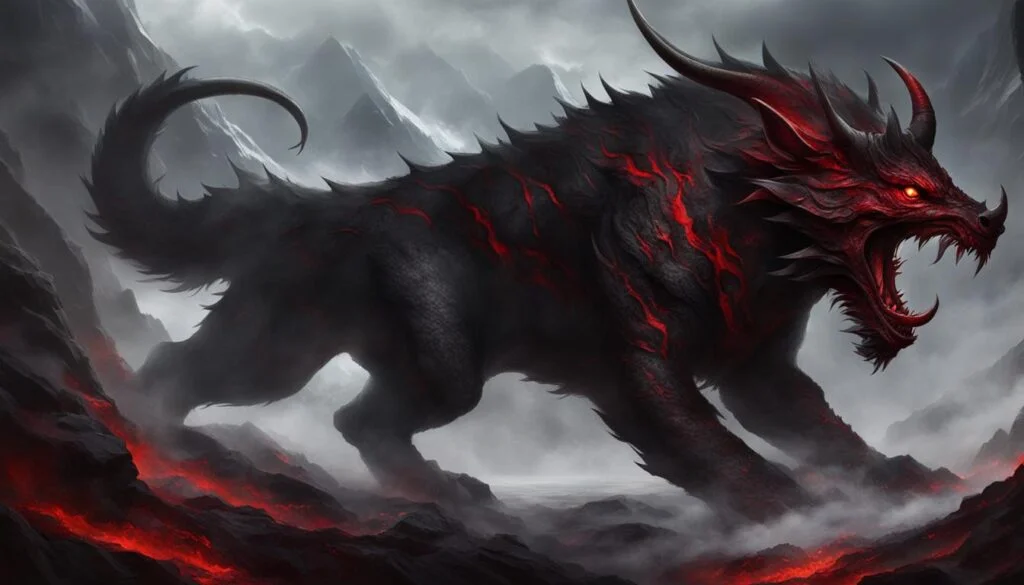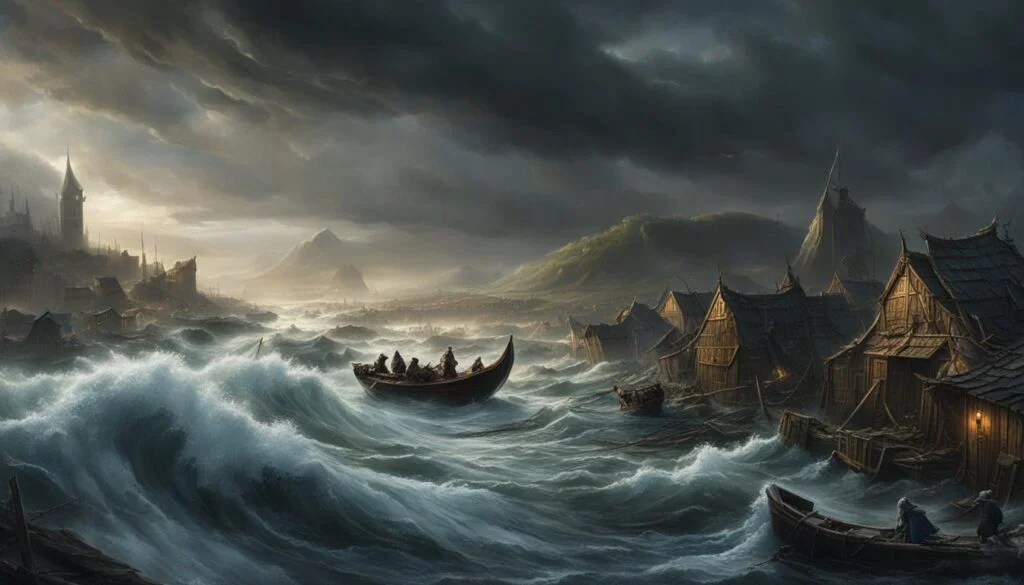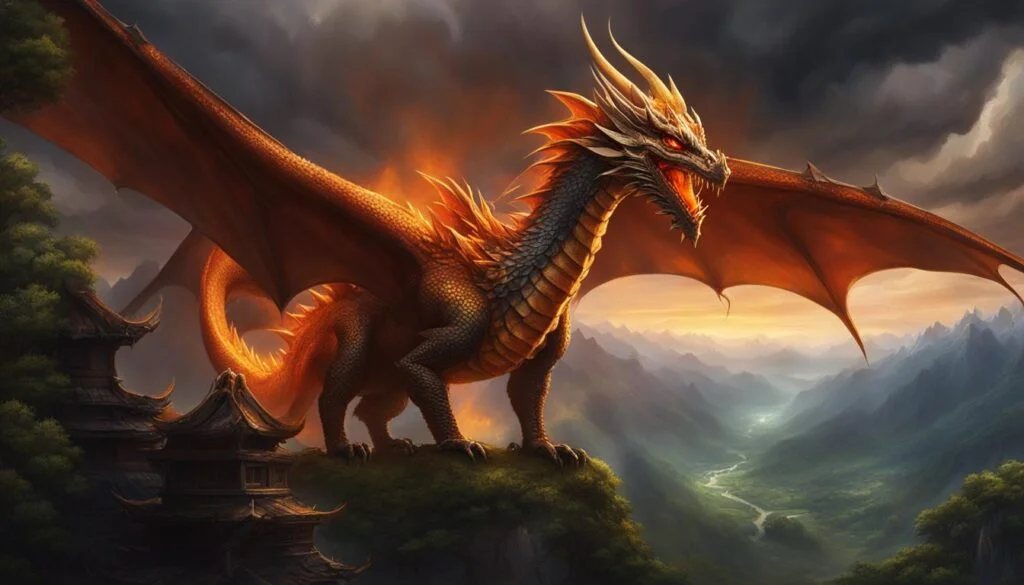Norse mythology is known for its captivating tales of gods, heroes, and mythical creatures. While the presence of traditional demons may not align with Norse mythology’s belief system, there are several beings that exhibit dark and malevolent traits. In this article, we will delve into the realm of Norse mythology and explore the existence of demonic-like entities within its rich narrative.
Key Takeaways:
- Norse mythology does not have a direct equivalent to traditional demons, but it has various beings with dark traits.
- Entities like Loki and his monstrous children, along with giants and undead creatures, embody demonic qualities.
- Words like “illgæfa” or “illgæti” in Old Norse represent the concept of evil or malevolence.
- Nidhogg, Garm, Skoll, and Hati are notable named creatures associated with darkness and chaos.
- Surtr, though not classified as a demon god, symbolizes immense destruction and plays a pivotal role in Ragnarok.
Are There Demons in Norse Mythology?
While Norse mythology does not directly feature the concept of demons as commonly understood in Christian or Islamic beliefs, there are various beings within Norse mythology that exhibit qualities akin to demonic entities. These malevolent beings possess dark aspects and are associated with chaos and destruction.
One such example is Fenrir, a giant wolf and the son of the trickster god Loki. Fenrir’s monstrous nature and role in bringing about the end of the world during Ragnarok align him with the characteristics often associated with demons.
An image that represents the malevolent beings in Norse mythology:
What are Demons Called in Norse?
In Norse mythology, the language of the Vikings does not provide a direct equivalent for the term “demon” as it is commonly understood in modern times or within other religious contexts. However, Norse mythology does feature a variety of malevolent beings, supernatural creatures, and monsters that possess dark characteristics. These entities are not typically classified under a specific term that corresponds to “demon,” but there are terms like “illgæfa” or “illgæti” that refer to bad luck, misfortune, or evil spirits. These terms help to represent the concept of evil in the rich mythological narratives of the Norse tradition.
Norse Mythology Devil: Loki and His Children
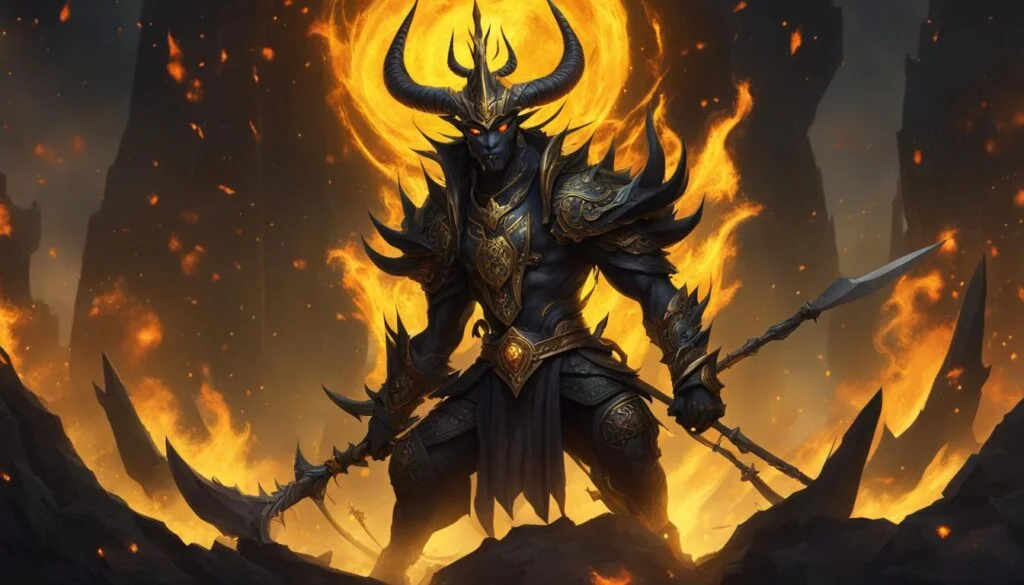
While there is no direct equivalent to the devil figure in Norse mythology, the god Loki is often associated with malevolence and chaos. Loki’s actions have caused strife among the gods, and his children, such as Fenrir (a giant wolf), Jormungandr (a massive serpent), and Hel (ruler of the realm of the dead), are often considered monstrous beings. Although they may not be classified as demons, their destructive nature aligns them with the concept of demonic beings in Norse mythology.
Monstrous Children of Loki:
- Fenrir: A ferocious and unstoppable giant wolf destined to play a significant role in Ragnarok, the ultimate battle of the gods.
- Jormungandr: A colossal serpent that encircles the world, poised to unleash its venomous fury during Ragnarok.
- Hel: The ruler of Helheim, the realm of the dead, where the souls of those who did not die in battle reside.
While Loki’s children may not be traditional demons, their monstrous nature and potential for destruction make them formidable figures in Norse mythology, contributing to the intricate tapestry of malevolent beings within the lore.
Monsters of Norse Mythology
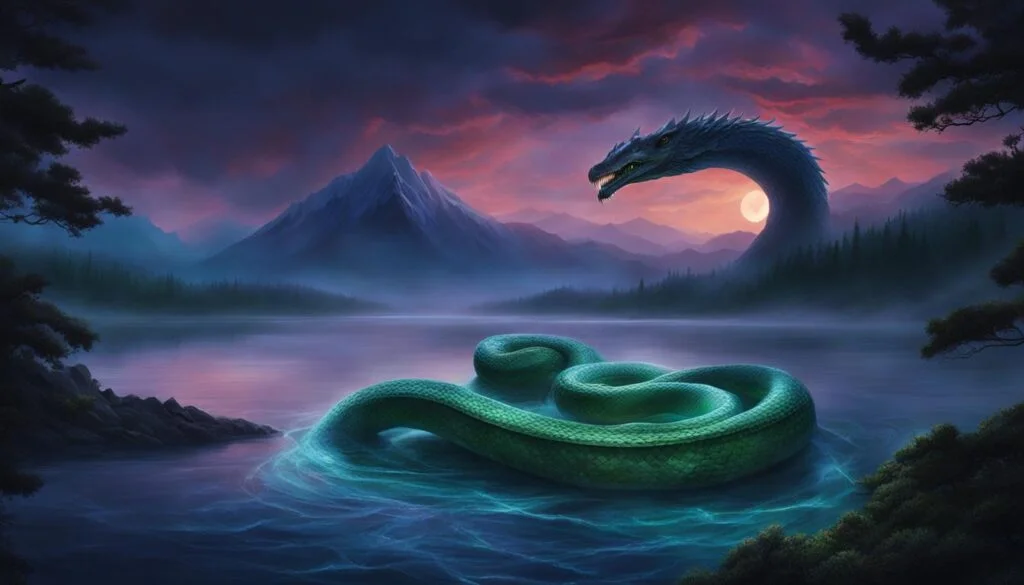
Norse mythology is teeming with monstrous creatures that embody malevolence, chaos, and destruction. These creatures contribute to the rich and captivating world of Norse tales, adding an element of danger and suspense to the mythological narratives.
Loki’s Monstrous Children
A prominent group of monsters in Norse mythology are the offspring of Loki, the trickster god. These include:
- Fenrir: a monstrous giant wolf destined to bring about the end of the world, Ragnarok.
- Jormungandr: a massive serpent who coils around the world, ready to clash with the gods during Ragnarok.
- Hel: ruler of the realm of the dead, Helheim, where the souls of the dishonorable dead reside.
These monstrous children of Loki symbolize chaos and destruction, serving as formidable adversaries to the gods and embodying the darkness that exists within Norse mythology.
Giants (Jötnar)
Giants, known as Jötnar in Norse mythology, are significant foes that often oppose the gods. They are colossal beings associated with raw power and primal forces. Giants like Surt, the fire giant from the realm of Muspelheim, and Ymir, the primordial giant whose dismembered body formed the world, epitomize the clash between order and chaos.
Undead Creatures: Draugr
In Norse mythology, undead creatures called Draugr roam the land. These malevolent beings were once warriors or individuals who died under tragic circumstances and returned to haunt the living. Draugr possess superhuman strength and a thirst for human flesh, making them nightmarish adversaries in Norse tales.
Trolls and Dark Elves
Trolls and dark elves are other monstrous creatures in Norse mythology with their own dark aspects and characteristics. Trolls are large, brutish beings that prey on humans and exhibit destructive behavior. Dark elves, known as Dökkálfar, are malicious entities associated with trickery and dark magic.
These various monstrous creatures in Norse mythology contribute to the ongoing struggle between order and chaos, illustrating the complex and enthralling nature of this ancient mythological tradition.
Norse Demons List: Giants, Dwarves, and Draugr
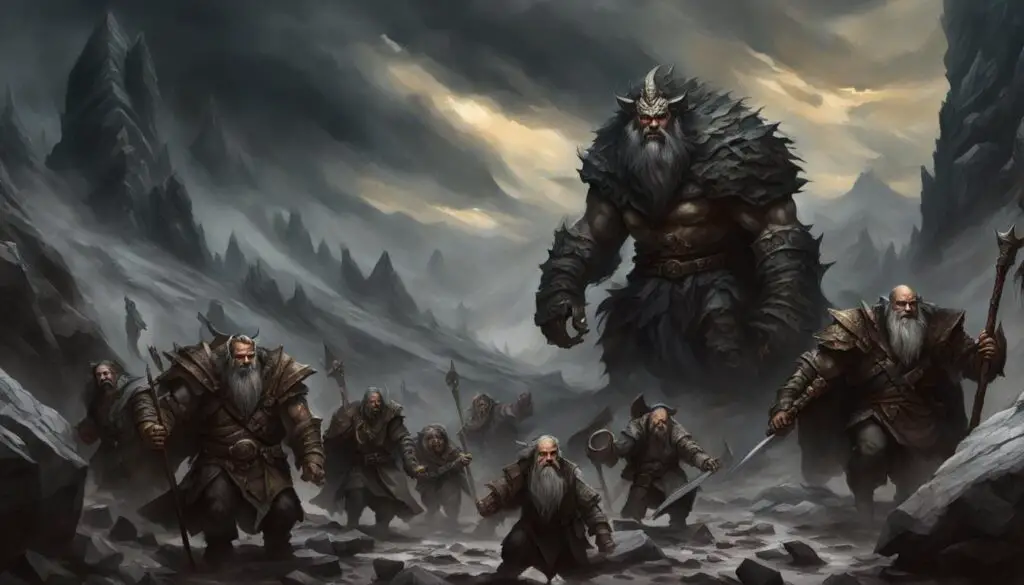
Norse mythology is teeming with a host of malevolent entities that can be likened to demons. Among these entities are giants, dwarves, and draugr. While not always inherently evil, giants often partake in destructive acts and stand in opposition to the gods. Dwarves, on the other hand, possess dark and twisted natures. Some, like Fafnir, even undergo a transformation into fearsome dragons. And then there are the draugr, undead beings that haunt the living and possess a malevolent nature, driven by an insatiable hunger for human flesh. These Norse demons contribute to the rich tapestry of malevolence within the realms of Norse mythology.
Giants, dwarves, and draugr are prominent figures within Norse mythology. Let’s take a closer look at each of these malevolent entities:
Giants
- Giants, or Jötnar, are immense beings known for their immense strength and stature.
- They often engage in destructive acts and oppose the gods, sparking conflicts and chaos.
- While not inherently evil, their actions and association with chaos align them with the concept of demonic entities in Norse mythology.
Dwarves
- Dwarves possess dark and twisted natures, often portrayed as cunning and deceitful.
- Some dwarves, like Fafnir, undergo transformations into powerful and fearsome dragons.
- Their darker aspects and actions contribute to their characterization as malevolent beings in Norse mythology.
Draugr
- Draugr are undead beings that haunt the living and are driven by their malevolent nature.
- They are known for their insatiable hunger for human flesh.
- Their presence instills fear and serves as a reminder of the darker aspects of the mythological world.
Norse Demons Names: Nidhogg, Garm, Skoll, and Hati
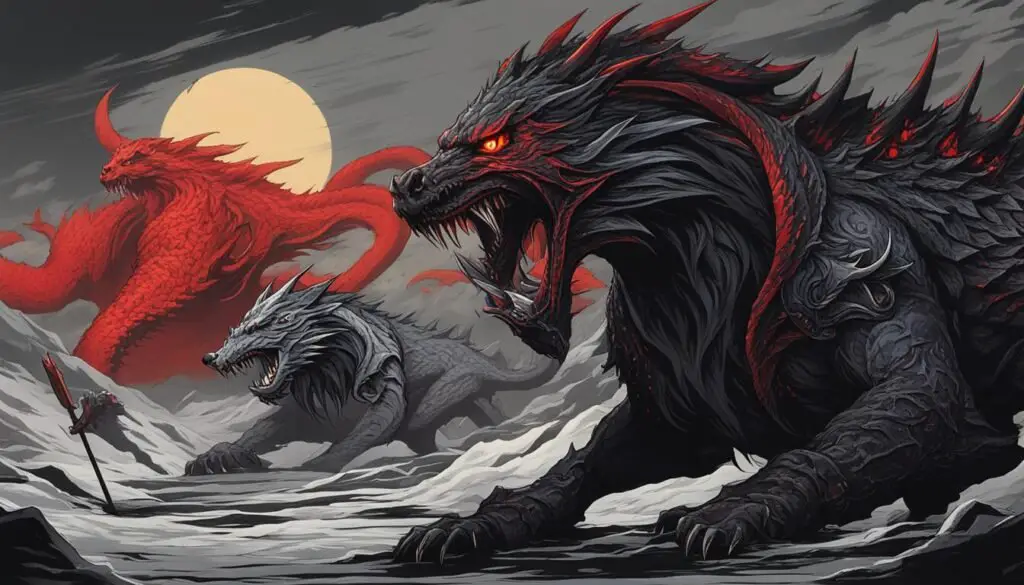
In Norse mythology, several named creatures personify darkness and evil, adding suspense and intrigue to the mythological narrative. These malevolent beings include:
- Nidhogg: A powerful serpent that symbolizes decay and destruction. It relentlessly gnaws at the roots of Yggdrasil, the World Tree, contributing to the eventual downfall of the cosmos.
- Garm: A monstrous hound tasked with guarding the entrance to Hel’s realm, the realm of the dead. Garm is associated with death and represents the terrors that await those who enter the underworld.
- Skoll: One of two giant wolves in Norse mythology, Skoll relentlessly chases the sun throughout the day, aiming to catch and devour it, bringing darkness and chaos to the world.
- Hati: The brother of Skoll, Hati pursues the moon with the same intent of causing darkness and upheaval. These two wolves are integral to the cycle of day and night in Norse mythology.
These named Norse demons embody the forces of darkness, chaos, and destruction within the mythological pantheon, adding depth and complexity to the overall narrative.
Evil Spirits in Norse Mythology: Valkyries, Dark Elves, and Trolls
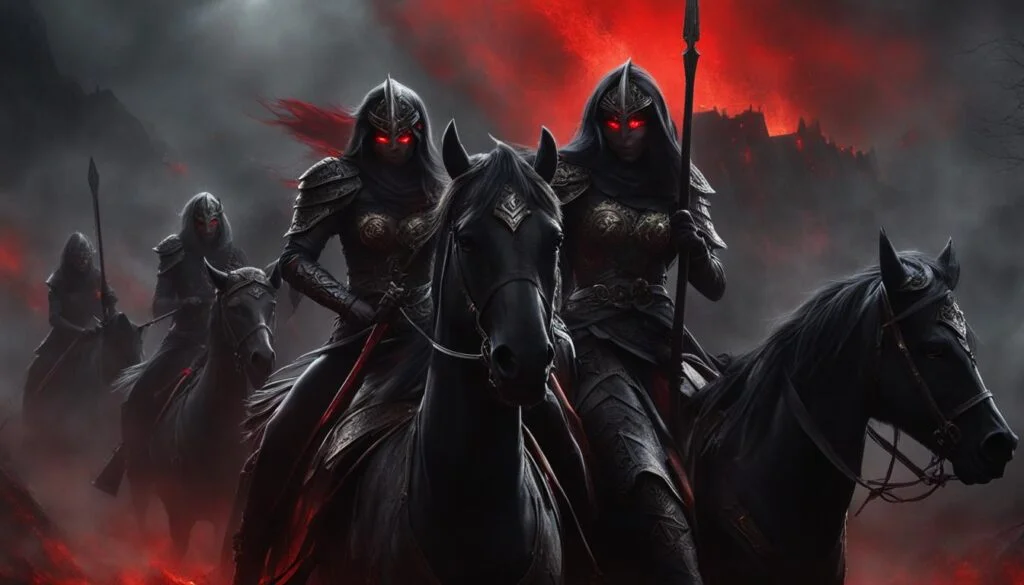
While Norse mythology may not have traditional demons, there are spirits and entities that embody dark aspects in their nature. These malevolent beings add intrigue and complexity to the Norse mythological narrative.
Valkyries
Valkyries, though not inherently evil, are associated with death and possess a darker nature. These powerful female spirits are responsible for guiding slain warriors to the afterlife. Their presence in Norse mythology emphasizes the connection between battle and the realm of the dead.
Dark Elves (Dökkálfar)
Dark elves, known as Dökkálfar, are malicious beings associated with trickery and dark magic. Unlike the light elves (Ljósálfar) who embody beauty and enlightenment, the dark elves dwell underground and are known for their malevolent nature.
Trolls
Trolls, large and malevolent creatures, feature prominently in Norse mythology. These monstrous beings prey on humans and exhibit destructive behavior. Often depicted as living in mountains and forests, trolls embody darkness and chaos.
While not explicitly labeled as demons, the presence of these evil spirits in Norse folklore adds depth to the mythological world. They contribute to the ongoing struggle between order and chaos, showcasing the multifaceted nature of Norse mythology.
Norse Demon God: Surtr
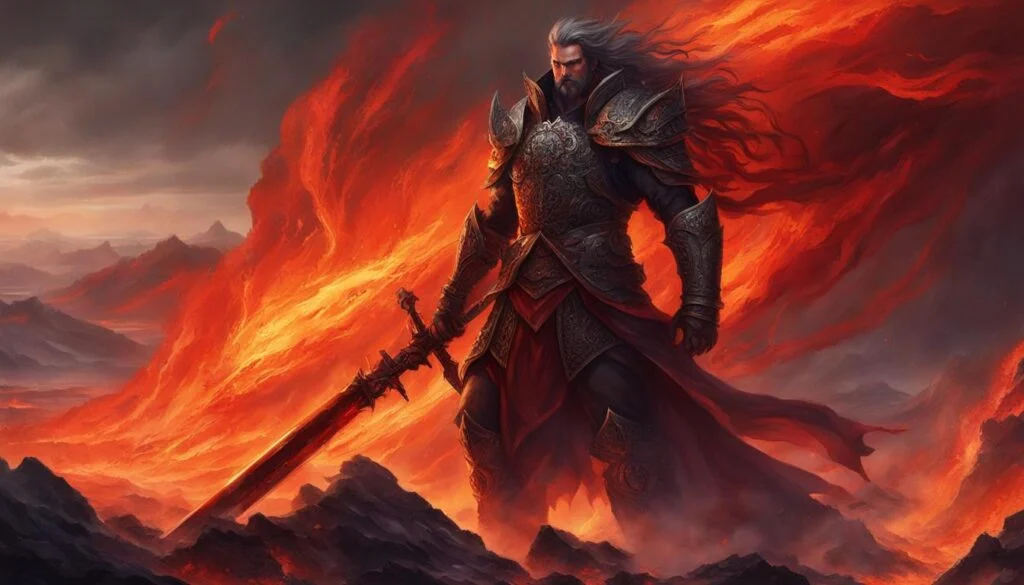
Surtr, while not technically a demon god, is a figure of immense destruction and calamity in Norse mythology. This fire giant from the realm of Muspelheim wields a flaming sword and leads an army of fire giants. His role in Ragnarok, the prophesized end of the world, involves bringing about the fiery destruction of the cosmos. Surtr’s embodiment of chaos, darkness, and destruction firmly places him among the most powerful and fearsome entities in Norse mythology.
Who is The Darkest Norse God?
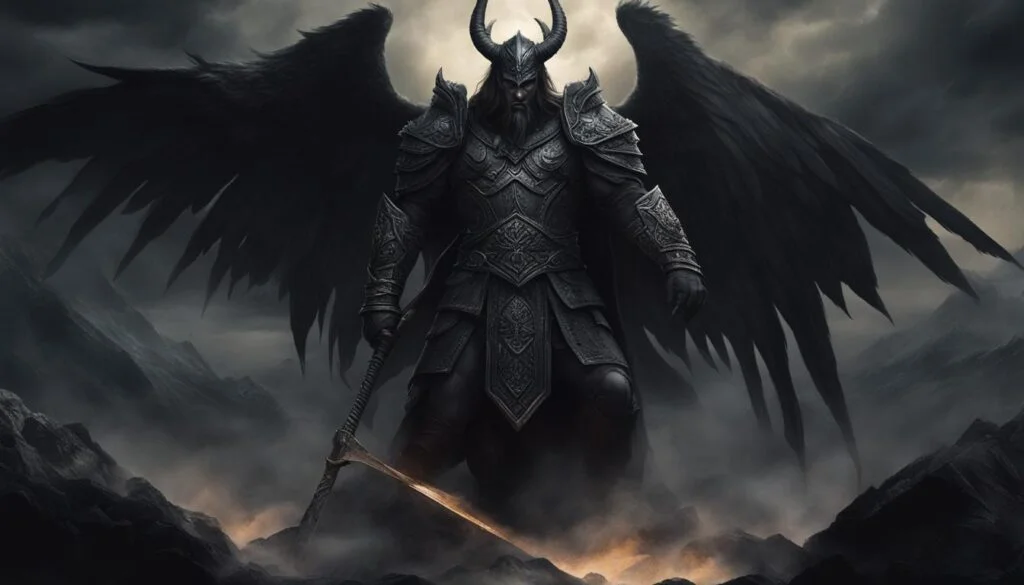
While Norse mythology does not have a traditional concept of a “darkest” god, Loki, the trickster god, often represents chaos and mischief. As the son of a giant, Loki’s actions frequently lead to turmoil and conflict among the gods and mortals. However, it is important to note that the Norse gods are not strictly aligned with ideas of good or evil, but rather with order and chaos. Loki’s darker aspects and his role as the father of monstrous beings contribute to his characterization as a morally complex figure in Norse mythology.
In Norse mythology, Loki stands out as a malevolent deity in the Norse pantheon. His mischievous nature and association with chaos make him a complex and intriguing character. As the son of the giant Farbauti and the giantess Laufey, Loki possesses a deep connection to the darker forces of the cosmos.
Loki and his Dark Influence
Loki’s actions often have far-reaching consequences and bring about great upheaval among the gods and the mortal realm. He assumes different forms, including that of a woman, a fly, and even a giantess. Loki’s shape-shifting abilities reflect his ability to deceive and manipulate others for his own amusement.
One of Loki’s most notorious acts is the orchestration of Baldur’s death, the beloved son of Odin. This act unleashes a chain of events that ultimately leads to the beginning of Ragnarok, the apocalyptic battle that brings about the destruction and rebirth of the world.
Loki’s Offspring: Monstrous Beings
Loki’s association with darkness is further emphasized through his children who are often depicted as monstrous beings. His three most notable children are Fenrir, Jormungandr, and Hel.
- Fenrir: A monstrous wolf, Fenrir’s immense size and ferocity make him a formidable enemy of the gods. He plays a key role in Ragnarok, where he ultimately kills Odin.
- Jormungandr: Also known as the Midgard Serpent, Jormungandr is so massive that it encircles the entire world. It is destined to fight against Thor during Ragnarok, leading to both their deaths.
- Hel: Ruler of the realm of the dead, Hel resides in Niflheim and is responsible for receiving the souls of the deceased who did not die in battle. She has half of her body in the land of the living and the other half in the realm of the dead, symbolizing her connection to both worlds.
These monstrous offspring reflect both Loki’s darker qualities and the destructive forces that exist within Norse mythology. While Loki may not fit the traditional image of a “darkest” god, his actions and the beings he fathered contribute to the dark elements present in Norse mythology.
In conclusion, while Norse mythology does not have a designated “darkest” god, Loki stands out as a malevolent deity in the Norse pantheon. His association with chaos, his mischievous nature, and his offspring that embody darkness contribute to his characterization as a morally complex figure in Norse mythology.
Conclusion
In summary, Norse mythology may not have a direct counterpart to traditional demons, but it is replete with characters and creatures that embody darkness, chaos, and destruction. From Loki and his monstrous children to the giants and other malevolent entities, Norse mythology offers a captivating array of supernatural beings with demonic qualities. These entities add depth and complexity to the mythological narratives, highlighting the constant struggle between order and chaos within the Norse cosmology.
While the term “demon” may not be explicitly used in Norse mythology, there are plenty of figures that exhibit malevolent behavior, association with destruction, and dark aspects. Giants, dwarves, draugr, and other entities possess traits that align them with the concept of demons. Terms like “illgæfa” or “illgæti” capture the essence of evil spirits or misfortune in the Old Norse language.
Through the stories of these malevolent beings, Norse mythology explores the tension between the forces of light and darkness, good and evil. Whether it’s the chaos wrought by Loki, the destructive tendencies of giants, or the relentless pursuit of darkness by Skoll and Hati, these mythological narratives provide insight into the eternal struggle between order and chaos, leaving us with a profound appreciation for the intricacies of Norse mythology.
FAQ
Are there demons in Norse mythology?
While there is no direct equivalent to the concept of demons in Norse mythology, there are several beings with malevolent traits or dark aspects.
What are demons called in Norse?
In Old Norse, the language of the Vikings, there is no specific term for demons. However, terms like “illgæfa” or “illgæti” can represent the concept of evil spirits or misfortune in Norse mythology.
Who is the Norse devil?
Loki, the trickster god, is often associated with chaos and mischief. While he is not strictly a “devil,” his actions and his monstrous children align him with the concept of demonic beings in Norse mythology.
What are the monsters in Norse mythology?
Norse mythology introduces a variety of monsters, including giants, such as Jötnar, and creatures like the undead Draugr, trolls, and dark elves, each with their own dark aspects and characteristics.
What are some Norse demons?
Giants, dwarves, and draugr can be considered as entities with demonic qualities in Norse mythology. Giants often engage in destructive acts, dwarves possess dark natures, and draugr are malevolent undead beings.
What are the names of Norse demons?
In Norse mythology, there are several malevolent beings, including Nidhogg, a powerful serpent, Garm, a monstrous hound, Skoll and Hati, two giant wolves, among others.
Are there evil spirits in Norse mythology?
Norse mythology features spirits and entities like Valkyries, associated with death, dark elves known as Dökkálfar, and trolls, large and malevolent creatures, each possessing their own dark aspects.
Who is the Norse demon god?
While not technically a demon god, Surtr, the fire giant from the realm of Muspelheim, is a figure of immense destruction and calamity in Norse mythology.
Who is the darkest Norse god?
Norse mythology does not have a traditional concept of a “darkest” god. However, Loki, the trickster god, often represents chaos and mischief, and his actions contribute to a morally complex portrayal.


